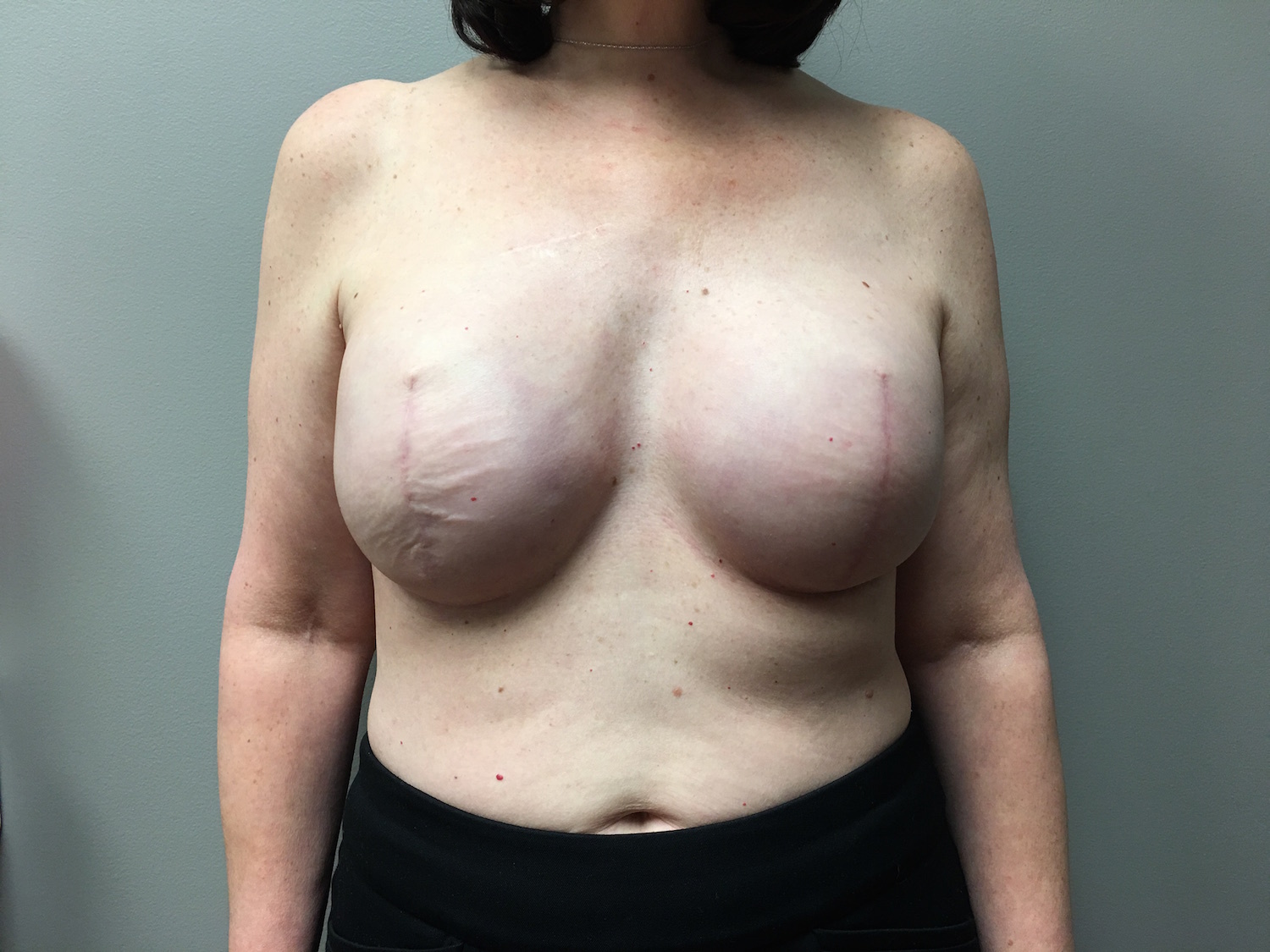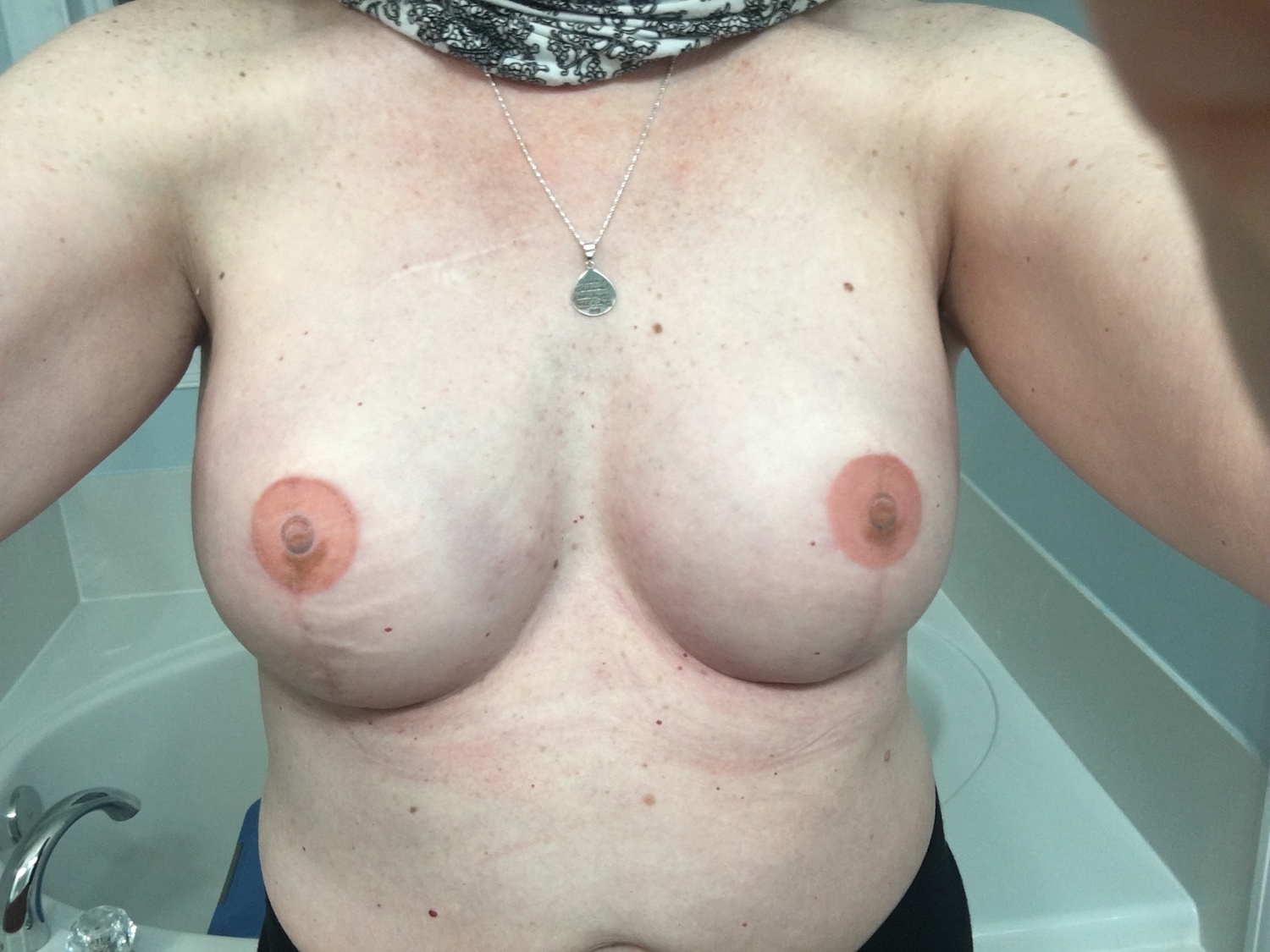As Lisa Chavis sits inside Haylo Healing Arts Lounge, a tattoo and permanent makeup studio in Charlotte, North Carolina, she admits she’s had a little liquid courage to prepare herself for this day.
In May 2016, Chavis was diagnosed with breast cancer in the areola. It wasn’t invasive, she says, but the treatment plan was a mastectomy. She ultimately decided to have both breasts removed because, as she puts it, “I’m a 54-year-old woman. I just thought, let’s just get rid of them both to prevent [this] from happening in the future. I’m not having any more babies, it’s not that important of a thing—it’s just a boob.”
Videos by VICE
Before she underwent the procedure, though, Chavis had to make a decision about her reconstruction: Would she leave her new breasts as is—meaning, as she puts it, looking “like a Barbie Doll” without any nipples?
Read more: The Young Women Getting Mastectomies to Prevent Breast Cancer
She also thought about the option to have new nipples created surgically. By the time a cancer survivor makes it to this stage, she’s typically dealt with a slew of medical procedures and treatments, and may not want to undergo another surgery. That was the case for Chavis.
Alternatively, Chavis could have gone the artistic route and opted for a brightly colored tattoo to cover her scars and commemorate her journey.
“I’m a more conservative kind of person,” she says. “I wanted to come back to my original state.” So she opted for three-dimensional areola micropigmentation, a noninvasive procedure that restores the areola via tattoo. Her decision to do so mirrors the experience of a growing number of breast cancer survivors who want to return to what they consider a state of normalcy for themselves.

Photo courtesy of Lisa Chavis.
While nipple-areola tattoos have long been used in breast reconstruction by surgeons, it’s only been in recent years that women have been turning to tattoo and permanent makeup artists for the service. Rose Marie Beauchemin, founder of the Beau Institute of Permanent Makeup in New Jersey, has been teaching the technique for years. She says as more people become aware of the option, she’s seen the demand for artists who know how to do it also grow. “And why not,” she says. “It’s the path of least resistance. It can spare her a surgery, which is huge, and get her to a more familiar and confident place without that additional procedure. It’s such a perfect result and a perfect choice.”
Many medical professionals agree. As one surgeon wrote for Plastic and Reconstructive Surgery in 2014, “The technique of 3D [nipple areola complex] tattoo presented is, in our opinion, a significant advance in obtaining improved aesthetic results for women undergoing breast reconstruction.”
According to BreastCancer.org, an estimated 255,180 new cases of invasive breast cancer are expected to be diagnosed this year in women in the US, in addition to more than 63,000 new cases of non-invasive breast cancer. It’s a condition that can significantly disrupt a woman’s life, both physically and emotionally. As the authors of a 2015 study note, “the experience of diagnosis and treatment of breast cancer may result in considerable distress. It is also known that a diagnosis of invasive breast cancer propels women into a time of uncertainty, that brings fear and emotional work. This disease oftentimes challenges a woman’s identity, self-esteem, body image and relationships.”
It’s a hopeful moment. And for most women it’s a very significant day that they truly remember.
That’s why for many survivors, it’s so important to return their body back to the way it looked before cancer. Not only can areola micropigmentation offer some sense of relief for a person who’s battled disease, says Cyrilla Lakeman, the resident permanent makeup artist at Haylo, but it may also help restore their self-esteem. “Some women just like the way it looks when they get out of the shower,” she says. “It makes them feel better about themselves, or it makes them feel more confident with their partner.”
Going the three-dimensional tattoo route instead of having nipples reconstructed surgically has another benefit. As Beauchemin explained to NJ.com in 2013: “Women are deciding that nipple grafts following a mastectomy are not always so great. For one thing, they stick out all the time. After breast reconstruction, you don’t have to wear a bra because the implant does not have the elasticity of a real breast. But once you get the nipple, you have to wear a bra with certain clothing.”
Chavis says that also played a part in why she went the tattoo route instead of nipple reconstruction. “Having a hard, unrelenting nipple all the time would bother me. It would be like being cold all the time—not always a good thing. I can wear anything—thin-cupped bra, thick-cupped bra, or no bra and I don’t have to worry about it.”

Photo courtesy of Lisa Chavis.
Lakeman, who’s done more than 50 areola renewals in the past two years, says the process isn’t much different from other kinds of body art. First, she draws the areola onto the woman’s breast, making sure to match it to its partner as best as possible. Then, she picks out the colors necessary to exact a three-dimensional effect. A topical anesthetic is then applied to the client’s breast, and within two or three hours, the work is complete. It takes about nine days to heal, similar to other tattoos, and Lakeman will often offer a second, touch-up session to perfect the work.
Read more: ‘I Felt Like I Was Alone:’ What It’s Like to Fight Breast Cancer in Your 20s
“It’s very symbolic of the final punctuation on the end of their journey,” Lakeman says. “Most women cry [after the procedure is finished]. They’re finally done. It’s a hopeful moment. And for most women it’s a very significant day that they truly remember.”
That was certainly the case for Chavis, who had her reconstruction in October, though opted to reconstruct her breasts but not her nipples.She says after her reconstructive surgery, she felt out of sorts with her new breasts, and recalls telling her doctor that she needed nipples. “It looked funny not having anything there,” she says. Her doctor recommended getting stickers or adhesives that resemble the look of nipples.
“I didn’t even bother doing that,” Chavis says. “That allowed me to learn to accept myself as I was at that point—without nipples, just the scars.”
“I think it’s important for women to learn how to accept the changes, as difficult as they are,” she continues. But she was adamant about doing the areola renewal, which she got done last week. “Getting this is just like a party for me now. I don’t feel any different prior to my diagnosis, which is great.”




